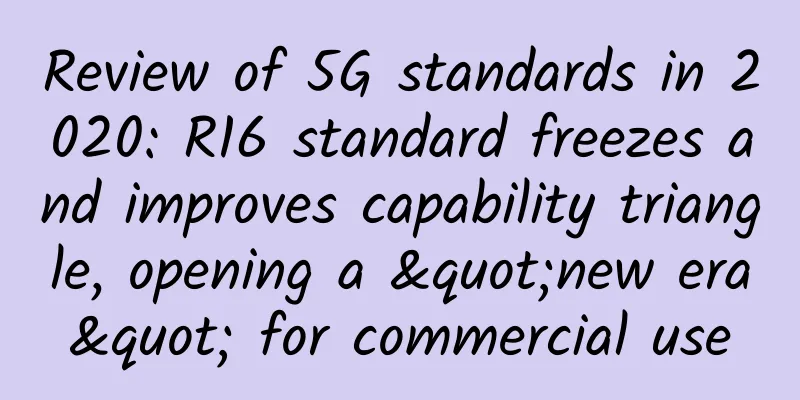Review of 5G standards in 2020: R16 standard freezes and improves capability triangle, opening a "new era" for commercial use

|
In order to better review the gratifying achievements made by the industry in the first year of 5G scale expansion and promote the further accelerated development of 5G in the future, as a top professional media in the industry with millions of precise users, C114 plans to launch a large-scale planned special report "2020-The First Year of 5G Expansion", conduct a year-end review of the 5G industry in the first year of expansion, and work together to promote the rapid and high-quality development of the 5G industry. 5G commercialization, standards first. In the most critical field of 5G technical standards, 2020 ushered in major progress: late at night on July 3rd, Beijing time, 3GPP announced the freezing of the R16 standard, marking the completion of the first evolution version of 5G standards. The freezing of the R16 standard has endowed 5G with greater vitality and richer application scenarios, enhanced the industry's confidence in the continued evolution of 5G technology, injected new impetus into my country's new 5G infrastructure, and become a key step in the standardization of 5G's expansion from consumer Internet to industrial Internet. Enhanced basic capabilities: making 5G more stable In early 2020, due to the impact of the global COVID-19 pandemic, 3GPP international meetings were fully transformed from face-to-face meetings to online electronic meetings, which delayed the freezing of the R16 technical standards from the originally planned March 2020 to June. Through the joint efforts of all parties in the global industry, the difficulty of not being able to hold face-to-face international standard meetings was overcome, and the R16 freeze was successfully completed in June. The completion and release of the R16 standard means that manufacturers can develop and manufacture corresponding products based on this version, further enrich the application scenarios of 5G technology, and further accelerate the global 5G network deployment process. Based on R15, the R16 version has made certain enhancements and improvements to the network's carrying capacity and basic functions, and added some new network features and capabilities. In terms of basic functions, wireless NR enhancement, V2X, mobility, support for 5G network automation architecture, service-oriented architecture, and network slicing have been optimized and enhanced, and the availability and completeness of functions have been improved. In terms of networking technology, remote interference management, wireless relay, and network organization and self-optimization technologies have been introduced to improve the actual user experience of the network. In addition, R16 also adds new functions such as terminal energy saving, positioning and location services based on 5G signals, which optimize the terminal user experience on the one hand and expand 5G positioning applications on the other. Building a “Capability Triangle”: Making 5G More Perfect Sun Tao, vice chairman of the 3GPP SA2 working group and senior researcher at China Mobile Research Institute, said that the biggest feature of R16 is the improvement of the "capability triangle". R15 defined the first version of 5G and provided the basic architecture of 5G. The scenarios it solved were mainly eMBB use cases and the basic functions of URLLC. On this basis, R16 deployed two types of scenarios, mMTC and URLLC, completing the other half of the "capability triangle". Qualcomm Vice President of Technical Standards, Shia Ko, also pointed out that 3GPP has completed the second version of the 5G standard, R16, which will significantly expand 5G to new services, spectrum and deployment modes, which is an important milestone for the entire mobile industry and the broader ecosystem. For low-power and large-connection application scenarios, the new core network complements IoT features and makes some innovations in combination with 5G. It is understood that CIoT was introduced since 3GPP R10 (2010), defining a series of network capabilities for the Internet of Things. R16 expands the capabilities of the 5G C new core network based on the existing NB-loT and eMTC air interfaces to support large connections. For the low-latency and high-reliability uRLLC scenario, in terms of high reliability, R16 provides two solutions for how to achieve data transmission reliability. One is dual links between the terminal and the service counterpart, and the other is double data replication and backup between the base station and the core network gateway. In terms of how to achieve both low latency and fast mobility, the solution provided by R16 is to establish an N9 forwarding channel between the source uplink classifier and the destination uplink classifier, so as to achieve fast terminal mobility and maintain business continuity when the gateway is replaced. R16 improves reliability and reduces latency based on the R15 version, overcoming the problem of reduced service performance and spectrum efficiency caused by the coexistence of URLLC services and eMBB services between or within UEs, and can be better applied to IIoT, V2X and other scenarios. Vertical industry expansion: making 5G richer The first version of 5G, R15, strived to produce "usable" standards as quickly as possible during the formulation process to meet the basic functions of 5G in many aspects. The R16 that has been frozen this time has achieved the transition from "usable" to "easy to use", and has further enhanced 5G's ability to better serve industry applications and improved 5G's efficiency by focusing on "expanding new capabilities", "exploring existing capabilities" and "reducing costs and increasing efficiency in operation and maintenance". For industrial Internet applications, new technologies are introduced to support 1 microsecond synchronization accuracy, 0.5-1 millisecond air interface delay, "six nines" reliability and flexible terminal group management. The fastest end-to-end delay of less than 5 milliseconds and higher reliability can be achieved, providing support for industrial-grade time sensitivity. For Internet of Vehicles applications, it supports direct communication between V2V (vehicle to vehicle) and V2I (vehicle to roadside unit). By introducing multiple communication methods such as multicast and broadcast, and optimizing technologies such as perception, scheduling, retransmission, and vehicle-to-vehicle connection quality control, V2X supports richer Internet of Vehicles application scenarios such as vehicle platooning, semi-automatic driving, external sensors, and remote driving. For industry applications, a variety of 5G air interface positioning technologies are introduced, and the positioning accuracy is improved by more than ten times to the meter level. In addition, R16 also introduces enhanced mechanisms in millimeter waves and unlicensed spectrum. Regarding millimeter waves, R16 enhances the robustness and reliability of beam management, which is specifically reflected in the ability to quickly restore the link between the terminal and the network in the event of obstruction or signal fading; regarding unlicensed spectrum, based on the 5G NR main body of licensed spectrum R15, a resource preemption process design is introduced to ensure fair use between it and other unlicensed spectrum technologies. Compared with R15, R16 standard has made many enhancements, but it is not the end of 5G standard; on the contrary, many features of R16 have truly opened the "new era" of 5G era. In order to cater to the emerging new demands for communication in various industries, 5G version will be continuously updated, and combined with the new demands generated after the launch of R16, new 5G standard version R17 and even R18 will continue to be generated. On December 7, Beijing time, 3GPP officially postponed the freezing time of 5G R17 standards by another half year, that is, the standard freezing will be completed in June 2022. China Mobile Research Institute said that two versions of 5G technical standards have been released, which can better meet the "capability triangle" requirements proposed by ITU, so the negative impact of the extension of the freezing of R17 standards on 5G commercial use is limited. However, some technologies from 0 to 1 in the R17 standard, such as NTN technology that brings 5G to satellites, require the industry to wait patiently for a while. |
<<: Will Wi-Fi cost more than 5G connections?
>>: Is quantum internet coming? High fidelity and long distance are its characteristics
Recommend
HostHatch: Hong Kong/Tokyo/Singapore AMD EPYC series starting from $25/year, 2GB/25G NVMe/1TB monthly traffic
HostHatch has released a new promotion plan on LE...
Huawei releases four new smart security products to usher in a new era of AI and win-win intelligence
[51CTO.com original article] Recently, Huawei'...
BandwagonHost: CN2 GIA special price replenishment starting from $83.8/year, 2GB/40G SSD/[email protected]/multiple nodes optional
[Updated on February 27, 2024] Bandwagonhost has ...
Flash is dead, and its first victim appears: the router can no longer log in
Flash was once the memory of a generation, but it...
Bryan to launch fiber optic internet service
The city of Bryan, Texas, recently announced that...
The three major telecom operators have begun to deploy 5G messaging on a large scale
5G messaging, which is seen by the industry as We...
Juniper Networks MIST AI network solution gives network engineers "superpowers"!
[51CTO.com original article] Under the night, the...
How to troubleshoot 502 issues? Have you learned how to do it?
When I first started working, one time, the guy w...
Share a few DOS commands that are not outdated. Please save them if you need them.
Although DOS commands are getting further and fur...
2 and a half years have passed since the first year of 5G, but users are still reluctant to upgrade to 5G
[[419264]] Recently, it is understood that even t...
AT&T and Microsoft team up for private 5G edge deployment
To further accelerate its goal of deploying priva...
Ultra-wideband is no longer a highlight: 10 thoughts on 6G by Wu Hequan, an academician of the Chinese Academy of Engineering
At the Global 6G Technology Conference held recen...
When you "ping", do you know the logic behind it?
[[262430]] When we encounter a network outage, we...
Revealed: What secrets does the extra 1G of 5G contain compared to 4G?
With the continuous development of communication ...
How Apple's iCloud Private Relay powers enterprise VPNs
Apple's iCloud Private Relay service offers p...









